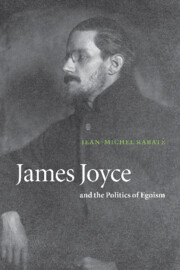Book contents
- Frontmatter
- Contents
- Preface
- List of abbreviations
- 1 Après mot, le déluge: the ego as symptom
- 2 The ego, the nation, and degeneration
- 3 Joyce the egoist
- 4 The esthetic paradoxes of egoism: from negoism to the theoretic
- 5 Theory's slice of life
- 6 The egoist vs. the king
- 7 The conquest of Paris
- 8 Joyce's transitional revolution
- 9 Hospitality and sodomy
- 10 Hospitality in the capital city
- 11 Joyce's late Modernism and the birth of the genetic reader
- 12 Stewardship, Parnellism, and egotism
- Notes
- Bibliography
- Index
11 - Joyce's late Modernism and the birth of the genetic reader
Published online by Cambridge University Press: 22 September 2009
- Frontmatter
- Contents
- Preface
- List of abbreviations
- 1 Après mot, le déluge: the ego as symptom
- 2 The ego, the nation, and degeneration
- 3 Joyce the egoist
- 4 The esthetic paradoxes of egoism: from negoism to the theoretic
- 5 Theory's slice of life
- 6 The egoist vs. the king
- 7 The conquest of Paris
- 8 Joyce's transitional revolution
- 9 Hospitality and sodomy
- 10 Hospitality in the capital city
- 11 Joyce's late Modernism and the birth of the genetic reader
- 12 Stewardship, Parnellism, and egotism
- Notes
- Bibliography
- Index
Summary
I have suggested how Joyce's sense of responsibility concerning the tragedy of Lucia's psychological troubles led him to turn her into a privileged addressee of his last book, until she became the ideal reader who somehow inhabits the text. Here lies the main effect of Joyce's Wake: to change if not its audience, at least its reading habits. We have also seen how the context of the thirties created a polarity between the avantgardist reader and a basic “plain reader.” The revolutionary idea of Finnegans Wake aims at modifying usual reading practices. Yet Joyce was not the only Modernist writer who believed in such a transformation: before him, Gertrude Stein had postulated the need to invent a “cubist” reader who could be persuaded to see words as colors or shapes, and Pound had vigorously defended the concept of a revitalization of language through poetry capable of destroying “sloppy thinking” and, perhaps, preparing for the new state. Joyce, however, was wary of such direct influence on the reader, and while keeping high esthetic standards, he remained aware of the ethical responsibility implied by the Modernist wish to create a new public.
The dierences between two critical “industries” of Modernism, the Pound and Joyce schools, can exemplify important variations in the emergence of a new genetic Modernism, the discovery of an original type of reading practice linked with a renewed attention to textual materiality.
- Type
- Chapter
- Information
- James Joyce and the Politics of Egoism , pp. 194 - 208Publisher: Cambridge University PressPrint publication year: 2001



